Where’s Annie? Berkeley’s beloved peregrine falcon is missing
It's been more than a week since Annie was seen on campus, where she and her mate Grinnell were readying for a sixth season of parenting.
February 28, 2022
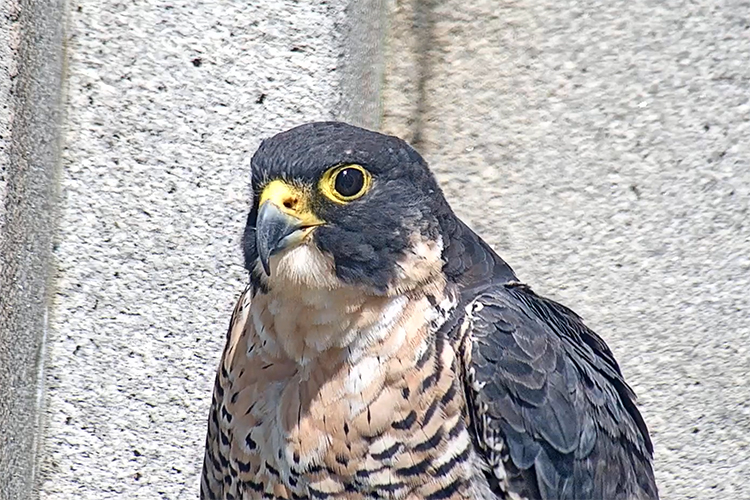
Annie, the campus’s longtime female peregrine falcon, hasn’t been seen for more than a week. (Cal Falcons photo)
Update: Annie has returned. For more information go to the updated story here.
Annie, the female peregrine falcon that’s lived atop UC Berkeley’s Campanile since late 2016 with her mate Grinnell, hasn’t been seen for at least a week, and her absence indicates that she likely has been injured, killed or has abandoned the territory, according to Cal Falcons, a group of bird experts and volunteers who monitor and are ambassadors for the campus’s well-known raptors.
Annie and Grinnell arrived on campus as a pair and chose the bell tower as their home. They’ve raised five broods of chicks since then and lately had again displayed regular courtship behavior. Annie was preparing their nest box for another season of raising chicks; typically, she lays eggs in March.
But it’s been since the start of last week that Annie, a strong, swift and fierce defender of her territory, a capable mother and a much-loved member of the campus community, was seen at or around the tower.
“Given the amount of time she’s been missing, it’s most probable that she’s gone,” said Sean Peterson, a Cal Falcons ornithologist. “The most probable scenario is she was injured or killed, perhaps in a territorial battle. It’s possible she was injured while hunting, too. Peregrine falcons are very aggressive hunters — they fly at great speeds when they’re hunting, and we know she hunts relatively regularly downtown, where there are a lot of obstacles. It’s possible she may have hit a building, window or car, or had something else go wrong hunting where she was injured.”
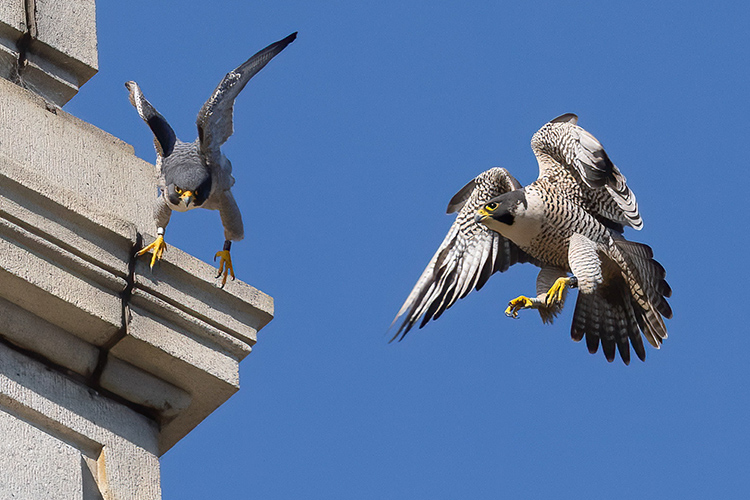
Grinnell (left) flies off the Campanile as one of the adult female falcons that lately has frequented the tower comes in for a landing. (Photo by Bridget Ahern)
Cal Falcons’ Mary Malec has called wildlife rehabilitation centers in the area, including Lindsay Wildlife Experience, where Grinnell was treated last fall after he was attacked by rival falcons. But so far, they have not received a wounded peregrine. Annie, estimated to be about eight years old, was not banded.
Although it’s not “impossible” that Annie is still alive, Malec said, it is “unlikely.” She added that the reason there have been several “floaters” — non-breeding adult birds of prey attracted to occupied territories — landing and staying on the Campanile lately is that Annie is not there.
Malec and a team of volunteers have been on the ground every day since last Wednesday, when she became concerned about Annie, to document current falcon activity on the tower.
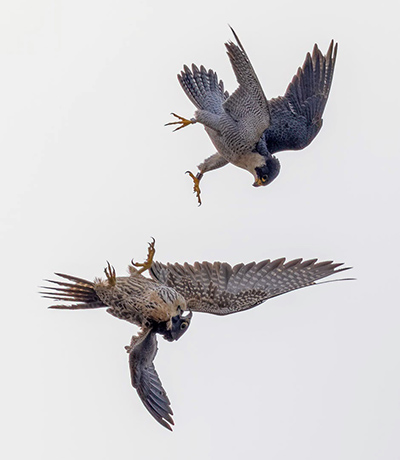
Grinnell (top) and a juvenile female falcon first seen at the tower in late February 2022 check each other out in mid air. (Photo by Bridget Ahern)
“On Saturday alone, we put in about 11 to 12 hours on the ground, plus there were more people monitoring the cameras,” she said. “On other days, there have been six to eight hours of time.” Yesterday, the volunteers also spent hours monitoring the area. Also helpful are the tower’s three webcams — one on the nest — that can reveal the falcons’ activities there 24/7.
Peterson said that some birds do recover from injury and return to their territories, “so it is possible that Annie got hurt and is off recuperating before coming back. … It’s possible, although less likely, that she abandoned the territory of her own volition.”
A few weeks ago, Annie flew off her nest when a drone flew near the tower. “She may have been spooked by the drone and decided to look elsewhere,” said Peterson, “but that’s fairly unlikely, given that she didn’t get close to the drone, and she’s seen them before.”
It’s rare that adult peregrines look for new territory if they’ve been successful where they are, Peterson added. Annie and Grinnell have had a total of 13 chicks; one, Lux, died in 2017 when she hit a window on campus while learning to fly.
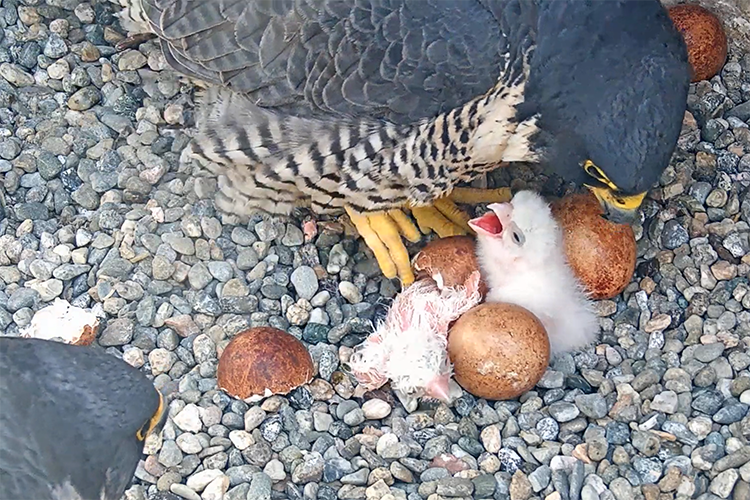
Annie tends to her hatching chicks in 2021, as Grinnell watches. (Photo courtesy of Cal Falcons)
Five months of drama, and counting
Since October, when Grinnell was badly injured and found atop a trash can at the Berkeley Tennis Club, the daily lives of Berkeley’s falcons — a source of comfort and distraction during the pandemic because of the birds’ beauty and seemingly stable existence during the past few years — have turned dramatic.
While Grinnell was hospitalized, the rival male falcon that had attacked him hung around the tower, and Annie showed interest in him. Once Grinnell was released, on Nov. 17, it wasn’t clear if he’d return to the tower and possibly face injury or death by confronting the rival.
Grinnell did fly back to the Campanile and remained there, along with his rival and without incident, for about a month. The rival left in mid-December, and on New Year’s Day, a webcam picked up Annie and Grinnell doing head bows to each other in a courtship display. Annie began readying the nest site, creating a small depression in the gravel.
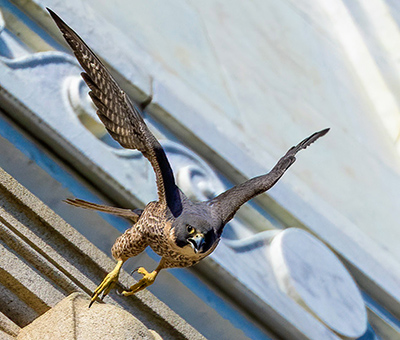
A juvenile female peregrine falcon seen recently on the tower takes flight. (Photo by Bridget Ahern)
Since then, if Annie had decided to reject Grinnell, “she would have driven him off the territory and waited for a new male,” not left the tower herself, said Peterson, dismissing another possible reason for Annie’s absence.
Three female falcons in search of a home have been circling the tower within the past week. One is a juvenile bird that hatched in 2021 — she is not Annie and Grinnell’s offspring, which all are banded — and the other two are adults.
The juvenile female was observed at the Campanile for hours on Saturday, said Peterson, “which is highly indicative that Annie is not in the area.” Grinnell has mostly tolerated the juvenile’s presence, although he chased her once when she approached him. One of the adult birds has also been seen briefly interacting with Grinnell on camera, but Grinnell appears “cautious, but defensive around her,” Peterson said, and the other adult was seen chasing Grinnell off his perch.
Despite being without his longtime mate, Grinnell seems “totally healthy” and is being cautious with the female floaters, said Peterson. In the past, he added, Grinnell was defensive toward larger female falcons that flew into his territory when Annie wasn’t around.
“If a new female falcon comes in, we hope that she would be receptive to mating with Grinnell, but that’s up to the birds,” said Peterson. “He will likely try to stay at the territory, so he will probably only leave if driven off by a new female or another male competing for the territory.”
Malec said Grinnell is “acting normally for a male peregrine. He is wary around the larger females that have come through lately, but he isn’t unfriendly. … Grinnell and any new female would need to go through a period of time of pair bonding.”

With Annie away, an adult female peregrine falcon walks along a ledge of the Campanile on Feb. 23, checking out Annie and Grinnell’s territory. (Photo courtesy of Cal Falcons)
‘An ambassador for her species’
It will take time for the campus community and Cal Falcons followers everywhere to adjust to life without Annie, should she fail to return. It’s a painful outcome that Cal Falcons members have both anticipated and dreaded for some time.
“We have known since Annie and Grinnell first came in 2016 that a time would come when one or the other would be replaced,” said Malec. “This territory is prime real estate and will always be attractive to other peregrines. Knowing that, and preparing for it in our minds, still doesn’t make it easy.
“This was a first pair for many of the people who follow Cal Falcons and will be their gateway to future peregrine love and knowledge. In that way, Annie and Grinnell have made a big contribution to us all.”
On New Year’s Day, it appeared that the falcon pair’s recent troubles were over, and that 2022 looked bright for Berkeley’s favorite birds. But those prospects are now dimming.
“Personally, I am pretty sad that after everything that’s happened since Grinnell got hurt, we may not get our fairy-tale ending,” said Peterson.

Annie has been known as a strong, swift and fierce defender of her territory and her offspring. (Cal Falcons image)
Lynn Schofield, another Cal Falcons biologist, admitted she’s also “mourning the loss of something that brought so many people together,” but said there remains some very good news: There are more wild falcons circling the Campanile today than existed in the entire lower 48 states 50 years ago, when the use of DDT — banned in 1972 — nearly wiped out many birds, including the peregrine. And, she said, there will be falcons nesting on the tower again, maybe this spring or summer.
Still, added Peterson, “It doesn’t feel right to use the past tense with Annie yet. … She was a wonderful mother and an excellent ambassador for her species. She was a part of thousands of people’s lives. Last time I looked, the Cal Falcon YouTube channel had about 390,000 hours of live stream video watched.
“That’s an incredible influence for an individual animal. I’m grateful that she brought so much joy to people’s lives and taught so many people about the wildlife living around them.”
Cal Falcons asks that if you see a downed peregrine falcon, please contact Lindsay Wildlife Experience.